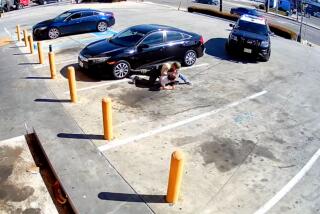Deadly altercation caught on tape in Kern County brings scrutiny
- Share via
The sharp cracks echoing from the East Bakersfield street were loud enough to jolt Ruben Ceballos from a midnight slumber. Then he heard screams.
The 19-year-old jumped from his living room sofa and hurried to the kitchen door, which offered a view of the violent scene outside – Kern County sheriff’s deputies repeatedly striking a man on the head with batons as he lay on the pavement.
“I saw two sheriff’s deputies on top of this guy, just beating him,” Ceballos said in an interview Monday. “He was screaming in pain … asking for help. He was incapable of fighting back – he was outnumbered, on the ground. They just beat him up.”
LIVE CHAT: Discuss the case at 9 a.m.
The man was David Sal Silva, 33, a father of four, and he was pronounced dead less than an hour later. The altercation last week was videotaped by witnesses and has roiled the Central Valley city for days.
One woman frantically called 911, telling the operator: “The guy was laying on the floor and eight sheriffs ran up and started beating him up with sticks. The man is dead, laying right here, right now. I got it all on video camera and I’m sending it to the news. These cops have no reason to do this to this man.”
In an unusual move, sheriff’s officials later detained for several hours two witnesses who had videotaped the incident on their phones. They were released only after they surrendered the phones to deputies.
“It makes it look like a coverup,” said David Cohn, a lawyer for Silva’s children and parents, adding he has not been able to see the footage. “What we’re all concerned about is, ‘Are these videos going to be altered? Are they going to be deleted?’”
Kern County Sheriff Donny Youngblood said in an interview Monday that it was too early in the investigation to reach any conclusions about Silva’s death. But he defended the decision to take custody of the phones as a way of preserving possible evidence. He said his office had obtained a search warrant for the phones.
“We still have to secure the evidence, especially when the evidence can tell us whether we did it right or wrong,” Youngblood said.
He said his agency, to remove the appearance of any conflict, has asked the Bakersfield Police Department to analyze the phone videos.
KERO-TV in Bakersfield broadcast a security camera video from the scene showing grainy images of figures pummeling someone on the ground, with about 20 swings of what appear to be batons or sticks. It’s difficult to see Silva in the seven-minute video or how many of the swings connected.
An earlier statement by the sheriff’s office said Silva might have been intoxicated and resisted the deputies’ efforts to restrain him, forcing them to use their batons. It said six deputies, a sergeant and two California Highway Patrol officers were at the scene. One deputy had a K-9 dog.
Silva stopped breathing and was taken to the hospital, where he was pronounced dead at 12:44 a.m. Wednesday, the statement said. Youngblood said it could take the coroner’s office up to four months to complete toxicology tests and determine a cause of death.
In an email to The Times on Monday, the CHP said it “is deeply sympathetic” to the Silva family and “takes seriously all incidents where an individual dies while in custody.” The patrol said it could not discuss the matter further because of the investigation.
The Silva episode follows several high-profile brutality cases involving the Kern County Sheriff’s Office in recent years.
One led to criminal convictions of three deputies and a $6-million civil judgment in the 2005 death of a jail inmate, according to attorneys. Another resulted in a $4.5-million court award for the family of a man who died in 2010 after being struck 33 times with batons and Tasered 29 times, attorneys said.
A deputy accused in the civil lawsuit over the 2010 death has the same name as one of those who confronted Silva. Youngblood would not confirm if it was the same deputy, however.
According to Cohn, Silva became upset Tuesday morning and abruptly left the home he shared with his girlfriend and their children. He later visited his mother’s house before turning up at Kern Medical Center seeking help for some sort of emotional trouble. He left the hospital when a security officer told him he could not sleep there, Cohn said.
Silva fell asleep in front of a house across the street, where the deputies confronted him, the attorney said. He said he did not know if Silva had been drinking.
Court databases show that Silva pleaded no contest in 2008 to a misdemeanor charge of disturbing the peace. He was charged with being drunk and disorderly two years later, but the case was dismissed.
Cohn represented the son of the inmate killed in 2005, an offshore oil field worker who was arrested after behaving erratically. “They don’t seem to have any training when it comes to people with a mental illness,” Cohn said of the Sheriff’s Office. “There seems to be a culture of striking first and asking questions later.”
Legal experts were surprised that deputies detained the witnesses for the purpose of seizing their phones.
Laurie Levenson, a Loyola law professor and former federal prosecutor, said the department’s tactics were “very heavy-handed, but technically may have been legal because the 911 call created a probable cause to obtain the videos.”
But she said law enforcement officers “cannot detain people for hours on end, and if they did here, that would be problem.”
Dmitry Gorin, a Los Angeles defense attorney, said: “The deputies could secure the house, but they cannot detain the people. The argument here would have to be they would not let them leave because they could take the cellphone with them. This is very unusual. I have never had a client detained in this way.”
ALSO:
UCI students vote to save campus newspaper
Temperature records set across Southern California
LAUSD board to vote on breakfast in the classroom, school police
More to Read
Sign up for Essential California
The most important California stories and recommendations in your inbox every morning.
You may occasionally receive promotional content from the Los Angeles Times.












